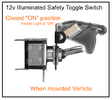Pepsikid51
New Member
Background: 4 "safety" toggle switches are used to control (Open or Close) a single circuit. The circuit is NOT directly attached to a load but in line with the load circuit. "Safety" (snap cover) switches are in UP (closed) position when armed, the Load circuit needs to be open, and upon changing them (closing cover) to the Down (open) position the Load circuit needs to be closed.
The type of toggle switch ("Safety") is mandatory, therefore its operation is fixed as UP (Closed/On), DOWN (Open/Off) but I need to create a circuit that reverses this result so that when ANY toggle is Open (Down) position the circuit to the load is Closed/On, not Off as is a normal application. How can this be achieved? It cannot be done just reversing wires to pins on switch, or reversing the mounting of the switch because the safety cover is "Keyed" to prevent it. Can a relay be used to reverse the logic of the switch on the switch side of circuit, or Load side of circuit.
Please be aware I can follow direction and drawings but schematics not so much. Any help is appreciated!
The type of toggle switch ("Safety") is mandatory, therefore its operation is fixed as UP (Closed/On), DOWN (Open/Off) but I need to create a circuit that reverses this result so that when ANY toggle is Open (Down) position the circuit to the load is Closed/On, not Off as is a normal application. How can this be achieved? It cannot be done just reversing wires to pins on switch, or reversing the mounting of the switch because the safety cover is "Keyed" to prevent it. Can a relay be used to reverse the logic of the switch on the switch side of circuit, or Load side of circuit.
Please be aware I can follow direction and drawings but schematics not so much. Any help is appreciated!



